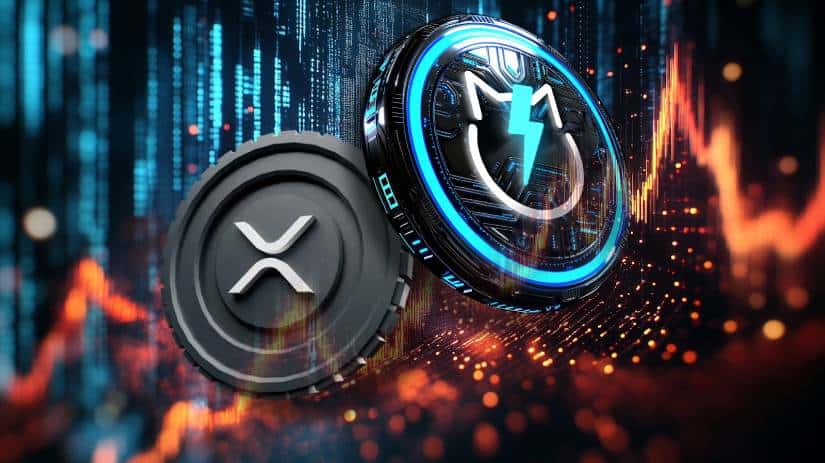XRP’s Bullish Surge: Regulatory Optimism and Institutional Interest Drive Price Targets
XRP has experienced a significant surge of over 3.5% within 24 hours, driven by a combination of heightened derivatives activity and growing regulatory optimism. Market data from Deribit highlights aggressive buying of $3 and $4 call options expiring on July 25, with open interest doubling since the beginning of July. Analysts from Bloomberg have raised the odds of SEC approval for a spot XRP ETF to an impressive 95%, further bolstering investor confidence. Additionally, Ripple's application for a national banking license is seen as a major step toward institutional credibility. The $3 strike price is currently dominating options volume, signaling strong market expectations for further price appreciation. With these developments, XRP appears poised for continued upward momentum as institutional and retail interest converge.
XRP Soars: Unexpected Developments Bolster Market Confidence
XRP surged over 3.5% in 24 hours as derivatives activity and regulatory Optimism fueled bullish sentiment. Deribit data reveals aggressive buying of $3 and $4 call options expiring July 25, with open interest doubling since July 1. Bloomberg analysts peg SEC approval odds for a spot XRP ETF at 95%, while Ripple's national banking license application adds institutional credibility.
The $3 strike price dominates options volume, with market makers taking the short side against retail buyers. September's $2.80 calls show concentrated selling activity, suggesting traders anticipate higher near-term targets. This derivatives frenzy coincides with growing conviction that XRP could breach $3 before July expiry.
Ripple's Banking License Pursuit Could Reshape XRP's Future
Ripple's strategic push for a U.S. banking charter signals a watershed moment for institutional crypto adoption. CEO Brad Garlinghouse confirmed filings with the OCC and New York regulators, positioning the firm to operate under dual oversight—a rarity in digital assets. The parallel application for a Federal Reserve master account through Standard Custody subsidiary could eliminate intermediary risks for RLUSD reserves.
Market analysts highlight broader implications beyond Ripple's operations. Securing Fed access WOULD create unprecedented stability mechanisms for the forthcoming stablecoin, potentially elevating XRP's utility in cross-border settlements. Garlinghouse frames the move as critical for "regulation-first infrastructure" amid growing scrutiny of stablecoin reserves.
The XRP community anticipates regulatory approval could trigger institutional capital inflows. Unlike speculative meme coins, Ripple's compliance-focused approach mirrors traditional finance playbooks—a deliberate contrast to the sector's wild west reputation. Banking integration may finally bridge the gap between crypto networks and legacy payment rails.
Ripple's Banking License Bid Could Propel XRP and RLUSD into Mainstream Finance
Ripple has taken a decisive step toward deeper integration with traditional finance by applying for a national bank charter with the Office of the Comptroller of the Currency. CEO Brad Garlinghouse framed the MOVE as an extension of the company's compliance-first ethos, aiming to set a new standard for trust in stablecoins. The application follows Ripple's existing New York BitLicense, which already subjects it to state-level oversight.
Through its subsidiary Standard Custody, Ripple also seeks a Federal Reserve master account—a rare privilege that would allow direct custody of RLUSD reserves at the central bank. Market observers note this dual-track regulatory approach could position XRP as a bridge asset between crypto and banking systems, while RLUSD may gain institutional credibility through Fed-backed reserves.
Analyst "XRP Investing" suggests approval could elevate Ripple's standing to rival traditional banks like JPMorgan, creating tailwinds for both XRP's utility and RLUSD's adoption. The potential trifecta of OCC supervision, NYDFS oversight, and Fed access marks an unprecedented convergence of crypto and traditional finance guardrails.
Ripple Pursues Federal Banking Charter to Bolster Stablecoin Credibility
Ripple Labs has formally applied for a U.S. national bank charter through the Office of the Comptroller of the Currency, marking a strategic push to legitimize its upcoming RLUSD stablecoin. Approval would place the San Francisco-based firm under dual oversight—combining its existing New York state license with federal supervision.
CEO Brad Garlinghouse framed the move as a watershed for institutional adoption, noting that federal recognition could position RLUSD as a benchmark for regulatory compliance in the $250B stablecoin market. The application follows Anchorage Digital's precedent as the only crypto-native firm currently holding a national bank charter.
Industry observers anticipate accelerated approvals under incoming OCC leadership, potentially catalyzing broader crypto integration with traditional finance. Ripple's bid coincides with mounting regulatory scrutiny of stablecoins following TerraUSD's collapse, suggesting calculated timing to differentiate RLUSD as a compliant alternative.
XRP Advocates Predict Historic Wealth Transfer as Ripple Disrupts Traditional Banking
XRP influencers are amplifying their bullish rhetoric, framing the asset as the cornerstone of a financial revolution. Coach JV, a prominent community figure, asserts that Ripple's technology isn't merely competing with legacy banking systems but actively replacing them. "The current infrastructure is obsolete," he tweeted, positioning XRP as the backbone of emerging value-transfer rails.
Ripple's regulatory progress and cross-border payment solutions lend credence to these claims. The company's ability to settle transactions in seconds at minimal cost contrasts sharply with traditional correspondent banking. XRP proponents see this efficiency gap as the catalyst for what Coach JV calls "the greatest wealth transfer in history"—a paradigm shift where early adopters stand to benefit disproportionately.
XRP Shows Bullish Reversal Potential Amid Market Volatility
XRP exhibits signs of a mid-term rebound despite warnings about holding losing positions. Trading at $2.28 with a 4% daily gain, the asset has fluctuated between $2.08 and $2.30 in recent weeks. A falling wedge pattern on the 12-hour chart suggests an impending breakout, with key support levels holding firm since May.
Analyst Mad Whale notes repeated tests of the wedge's lower boundary, including bounces from $2.08 on May 6 and $1.96 on June 23. The upper resistance NEAR $2.33 remains a critical threshold. A brief breach to $2.32 this week hints at growing bullish momentum, with technical indicators pointing toward a potential $2.55 target if the pattern confirms.

